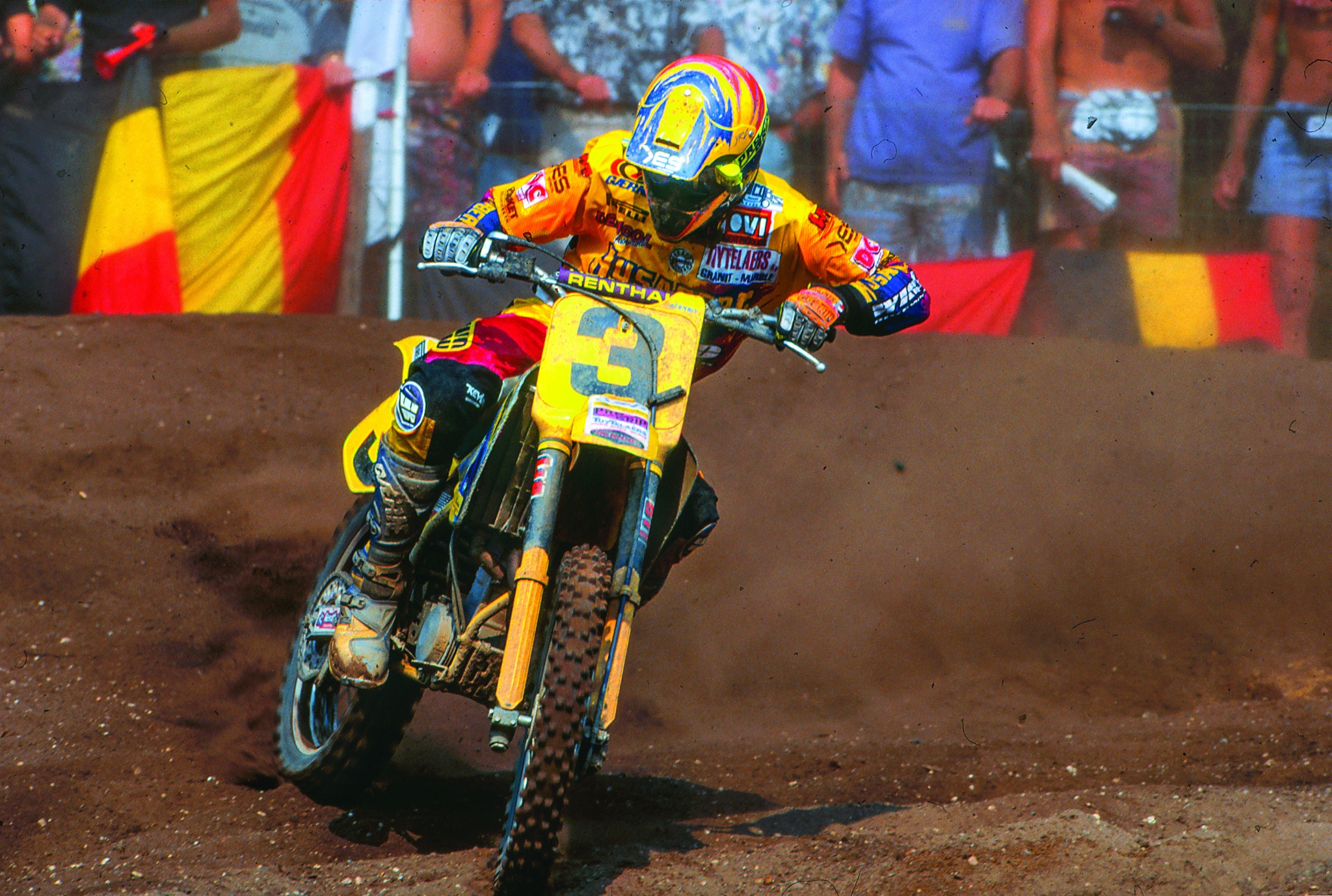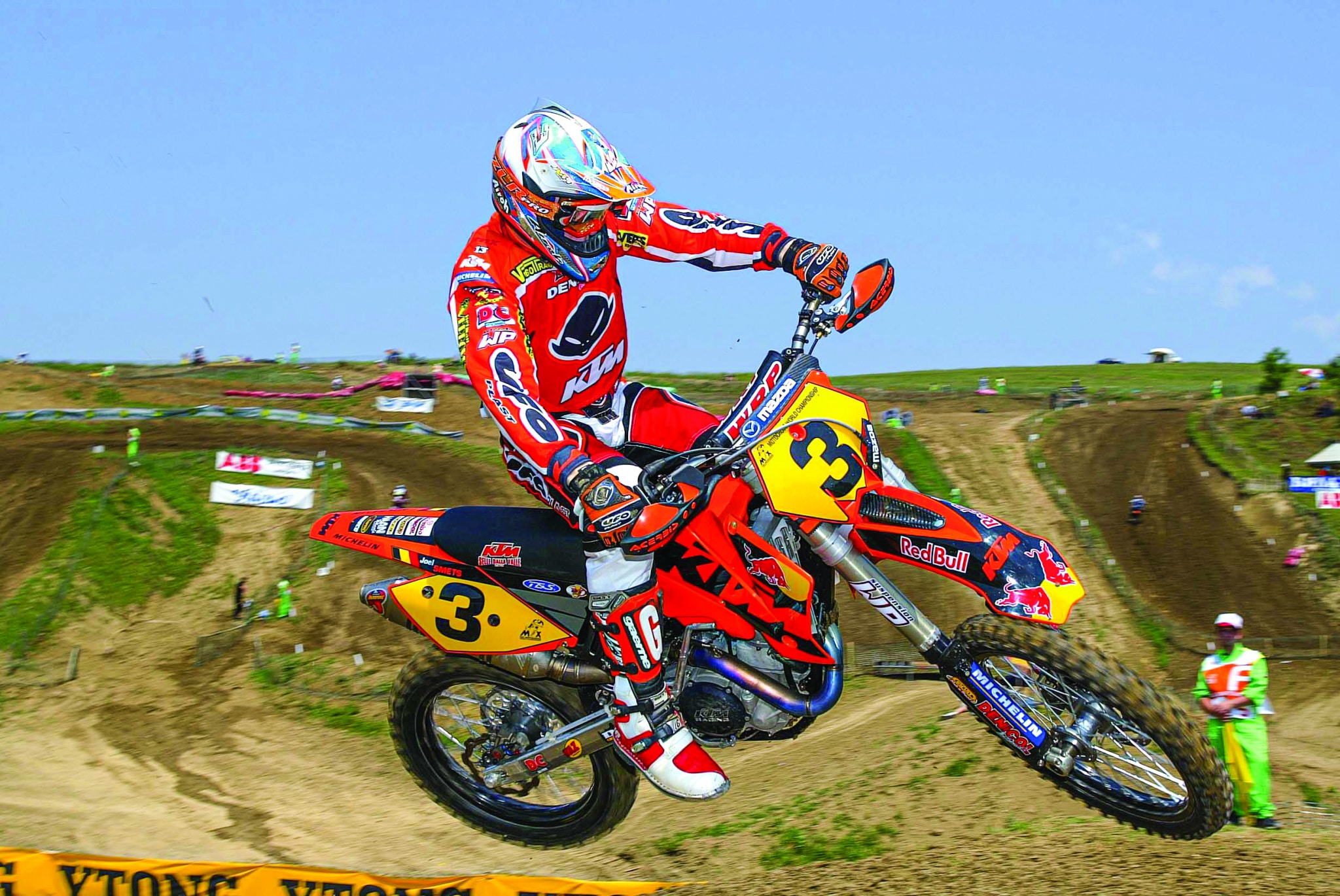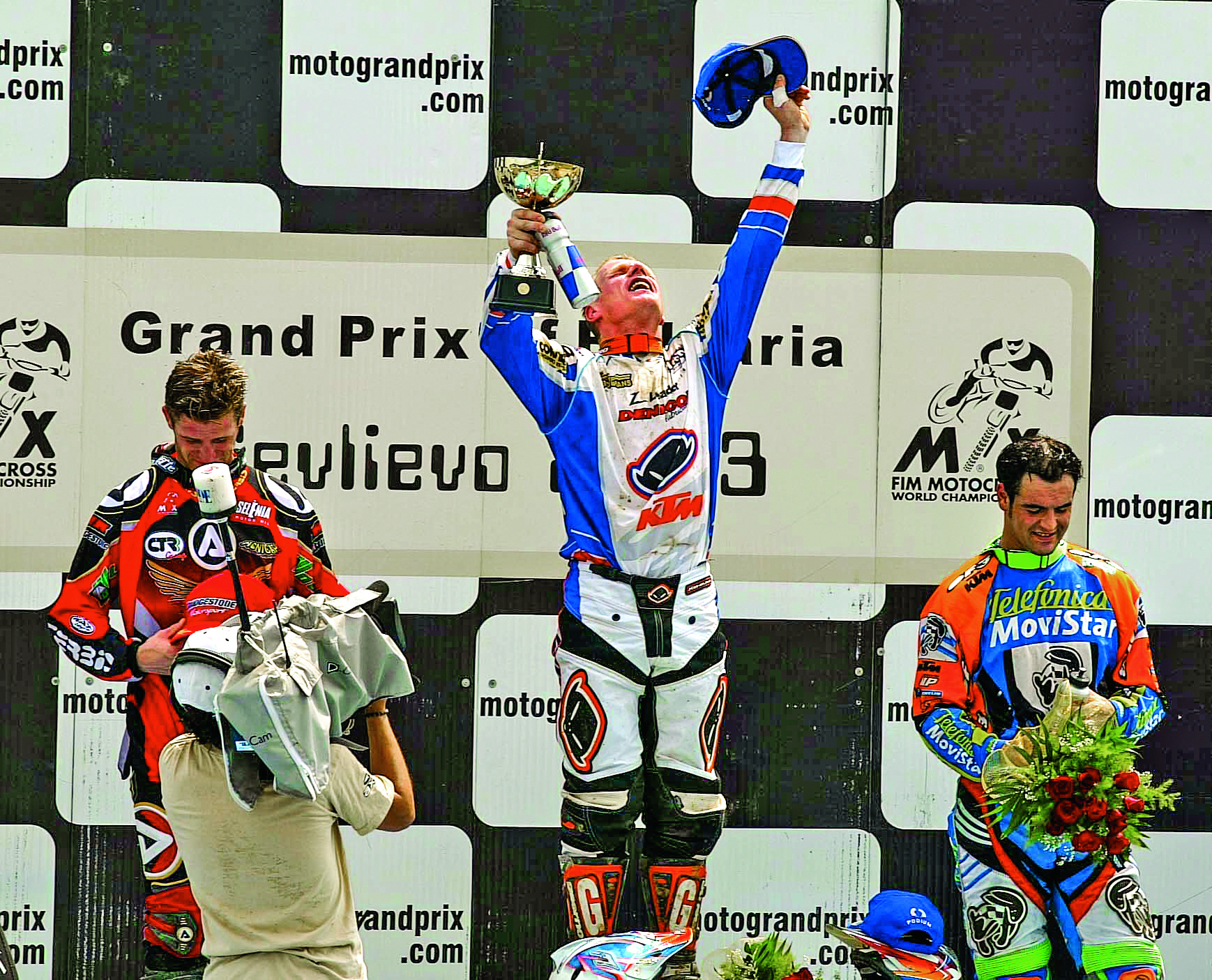MXA INTERVIEW: JOEL SMETS ON HIS GREATEST MOMENT & HIS BIGGEST MISTAKE

BY JIM KIMBALL
IS IT TRUE YOU WERE NAMED AFTER JOEL ROBERT? That is correct. My parents were definitely sports lovers with a preference for motocross. We lived in the same neighborhood as the Geboers family. Back in the day, Sylvain Geboers was having his fights with Joel Robert. My parents were fans and thought it was a nice name.
WITH ALL OF YOUR LATER SUCCESS, DO YOU RECALL YOUR EARLY MOTOCROSS RACES? Of course. I remember everything quite well. I didn’t come into motocross with a yearning to become a World Champion. I was over the moon with just having a motorcycle. I was 17 when I got my first bike; my only aim was to learn and get better every day.
TYPICALLY, IN AMERICA, YOU BEGIN RACING A MINI OR A 125. DID YOU FOLLOW THAT PATTERN? No, I never raced any small bikes because of my limited budget. I chose the 500 right away for maintenance reasons. It was the cheapest way to do it. I started out on the Yamaha YZ490 and later on a Honda CR500. That was the only chance for me to be a racer.
WHEN DID YOU WIN YOUR FIRST GP? The year 1990 was my first in the World Championship; I was a privateer on CR500s. In 1993, the year I won my first GP, I was a semi-factory rider riding a Swedish Husaberg.
 Smets on his factory Husaberg.
Smets on his factory Husaberg.
AFTER THAT FIRST WIN, DID YOU HAVE THE FEELING “I HAVE ARRIVED”? I was making quick progress. In 1990, I finished 46th in the Championship. In 1991, I finished 17th in the Championship, and in 1992, I improved to 4th in the championship. I was making progress but did not want to think about winning a World Championship. If you start at a late age, not only have you started late, you also have to set realistic goals, and that was my strength. I was good at setting realistic goals and not putting too much pressure on myself. My only aim was that “tomorrow needs to be better than today.” I believed that if I could win one GP, I should be able to win more. And if I won more, who knows, one day, I could win a Championship. That is how it happened.
“OF COURSE. I REMEMBER EVERYTHING QUITE WELL. I DIDN’T COME INTO MOTOCROSS WITH A YEARNING TO BECOME A WORLD CHAMPION. ”
AT THAT TIME, 500 TWO STROKES WERE THE STANDARD, BUT THE NEW FOUR-STROKES WERE COMING. IS THAT WHY YOU SWITCHED? It was not a tactical choice; it was a financial choice. After having finished 4th and being first privateer in 1992, I was hoping to get some support from Honda. My first two years in the championship were on CR500s, but I did not get any help from Honda. Then an offer came from Husaberg, which was on a four-stroke. I tested the bike and fell in love with the four-stroke, so that was a lucky coincidence. I got an offer where I could make a living from the sport, and at the same time, I could ride a bike that suited me well. I loved that bike, and it was unique because only Jacky Martens and I were on four-strokes. Fighting against all the two-strokes was amazing; you felt like the underdog.
THAT UNDERDOG FOUR-STROKE WAS SOON THE STANDARD. When the opening to race the four-stroke came up, I asked Roger DeCoster for advice. I asked him what he thought about four-strokes. Roger said, “Listen, in California, two-stroke engines will soon be forbidden in public places.” It did not eventually go that far, but somehow that advice from Roger helped me make the call. As usual, Roger was right.
IN 1994, YOU WENT TO VERTEMATI. WHAT WAS THAT LIKE? The Husaberg team I was racing for in 1993 was an Italian team. Something went wrong there, and the owners decided to build their own motorcycle based on a Husaberg engine. So, although the bike became a Vertemati, I was still racing for the exact same team. Vertematis were handmade, homemade bikes. It was not the same exact bike as the Husaberg, but riding wise, it felt similar.
 Joel racing on a factory KTM four-stroke.
Joel racing on a factory KTM four-stroke.
WHY DID YOU STAY THERE ONLY ONE SEASON? The main reason was that they did not get support from Husaberg, which they wanted and needed. Plus, with them building their own bike, there was very little practice or test time. I was racing a one-off prototype bike, and that is usually a bad sign for reliability. I had one or two DNFs too many; otherwise, I would have won the 1994 FIM 500 World Championship. But, that was the way it was. Vertemati was such a small team that I did not see any future there. I got an offer to return to Husaberg for 1995 and I decided to do that rather than be unsure with the Vertemati team in Italy.
DIDN’T YOU AND FIVE OTHER 500 GP RIDERS BOYCOTT THE SECOND MOTO OF A GP IN 1994? Yes, that was the Slovakian Grand Prix. It was a very muddy day, and there was one very steep uphill that was so difficult that many riders got stuck on it. You had to go up with some serious speed. The guys who didn’t make it were coming down backwards. It just got too dangerous in the first moto, and we did not want to take that risk, so that is why six of us made a stand.
All six of us, which included the top three in the 500 World Championship standings (Jacky Martens, Marcus Hansson and me) went to a room in the track’s clubhouse and stayed together there until the start of the race. We knew that if we went back to the paddock our teams would pressure us to race. We stayed together to guarantee that none of us would start the race and take points. (Editor’s note: Mervyn Anstie won his one and only Grand Prix that day).
IN 1995, AFTER RETURNING TO THE SWEDISH HUSABERG TEAM, YOU WON THE 500 WORLD CHAMPIONSHIP. WHAT WAS THE FEELING LIKE? I can’t describe it. Every time I am telling the story to somebody, it’s still hard to believe that it happened. For the rest of my life, it is going to be hard to believe. Starting at the age of 17 with your first bike, and eventually winning five Championships, you cannot write a better scenario for a movie. (Editor’s note: Joel won four FIM 500 World Championships and one FIM MX3 650cc Championship).
 Tony Cairoli and Joel.
Tony Cairoli and Joel.
WAS IT DIFFICULT DEFENDING YOUR CHAMPIONSHIP IN 1996? Yes, 1996 was a difficult year for me. Up until that point, from the day I started riding, I always looked upwards and tried to improve and get better. Then, suddenly, I was number one in the world, and the only thing I could do was the same as the year before. I couldn’t improve any more in terms of results, so mentally, it was not easy. Also, in those days, if you won the Championship, you were obliged to ride with the number-one plate on your bike.
“I FELT ALL EYES WERE ON ME—THAT I HAD TO PROVE THAT I DESERVED TO WIN THE CHAMPIONSHIP. I THOUGHT THAT I HAD TO WIN EVERY RACE. THAT WAS DEFINITELY NOT THE RIGHT WAY OF THINKING.”
SO, YOU FELT THE WEIGHT OF NUMBER ONE ON YOUR BIKE? I had a hard time coping with that. I felt all eyes were on me—that I had to prove that I deserved to win the Championship. I thought that I had to win every race. That was definitely not the right way of thinking. I made mistakes. Also, my 1996 bike wasn’t as good as the 1995 bike. The only big difference was the fork. I had been using WP upside-down forks in 1995, but in 1996 we changed to the conventional fork. All year long, I struggled with my front end. Coping mentally with having the number one on my bike and my fork problems made me lose the Championship.
HOW WERE YOU ABLE TO COME BACK SO STRONG IN 1997 AND 1998? I learned a lot from winning the Championship in 1995 and losing it in 1996. That experience made me really strong—physically, mentally and technically. I learned that if you want to win a Championship, you need to be prepared to lose some races. That strength carried through the rest of my career.
AFTER WINNING 1995, 1997 AND 1998 500 TITLES, YOUR RESULTS SUFFERED IN 1999. WHY? I was really strong and believed that I could dominate every race, but I had too many DNFs. We had a new engine. We thought we had an ignition problem, but it turned out to be a cylinder-head problem. It took us until the end of the year to solve it. That was a pity; I still won four races out of 12, but I could have won eight or nine. I could have won the Championship, but I finished third.
 Joel was adored by Belgium fans.
Joel was adored by Belgium fans.
WHY DID YOU SWITCH FROM HUSABERG TO KTM FOR THE 2000 SEASON? In reality, I had been riding for KTM since 1996, since Husaberg was the little brother of KTM. That was the best year of my career, results-wise and riding-wise. It was a completely new bike, but I loved it. For me, the most outstanding story of 2000 was that, for the first time in my career, I managed to win my home GP at Namur and eventually the World Championship. I get goosebumps when I talk about it. There were 30,000 spectators at Namur. When I made my lap of honor, I was scared that I was not going to make it back up to the pits. The crowd just went wild.
TELL US WHAT IT WAS LIKE TO WIN AT THE LEGENDARY NAMUR? To race there and win there was such a phenomenal experience. If you have never been there and witnessed a race, there is no chance you can understand what I am talking about. The level of technical difficulty, the atmosphere, the layout of the track, the forest, the Citadel, the steep downhills, the steep uphills, the rocks and the off-cambers were like nothing you see in today’s motocross. All of those things made it incomparable. I wish I could relive those days again.
WHAT WAS IT LIKE RACING MOTOCROSS IN THE EARLY DAYS? Motocross was so popular back then. I lived in a small village with less than 10,000 people. I remember racing in Germany, and half of my village was there cheering for me. They could all identify themselves with me. I have never seen so many adult people cry together.
STEFAN EVERTS MOVED TO THE 500 CLASS AND WON IN 2001 AND 2002. WAS HE THAT MUCH FASTER THAN YOU? Speed-wise, I was as fast as Stefan, but he was more consistent. Also, I was used to riding big bikes, while he was used to riding 125s and 250s. Coming off 500 two-strokes and 650 four-strokes, I was so used to the big power; the 450 required a different riding style. Stefan, with his 125 and 250 experience, adapted better.
THE FIM KILLED THE 500 WORLD CHAMPIONSHIP AND MADE IT THE MX3 WORLD CHAMPIONSHIP. WHAT WERE THOSE MX3 BIKES LIKE? Too powerful. I liked the big engines in the 450/MXGP class but not the 650. People could not ride them anymore; they just became too much. Also, the manufacturers didn’t have any interest in 650cc dirt bikes. I won the 2003 MX3 World Championship but decided to move to the 450 class for 2004.
 Smets raced for the Italian Vertemati team for one year.
Smets raced for the Italian Vertemati team for one year.
YOU LEFT KTM IN 2004 AND SIGNED TO RACE THE PROTOTYPE 2005 SUZUKI RM-Z450. WHY? KTM was focusing its efforts on road racing, and I felt like there was too much attention on the road side. I felt that my KTM 450SXF was not competitive enough to beat Stefan’s Yamaha YZ450F. Suzuki made me a very good offer, but Suzuki had never made a four-stroke or an aluminum motocross frame, so it was not an easy decision, especially since I had never seen the bike, let alone ridden it. But, Sylvain Geboers was running the team, and he convinced me to do it.
“TO RACE THERE AND WIN THERE WAS SUCH A PHENOMENAL EXPERIENCE. IF YOU HAVE NEVER BEEN THERE AND WITNESSED A RACE, THERE IS NO CHANCE YOU CAN UNDERSTAND WHAT I AM TALKING ABOUT.”
HOW WERE THE TWO YEARS AT SUZUKI? They were the biggest mistake of my career. It is a pity that I made that mistake at the end of my career. When I signed the Suzuki contract, I was already 34 years old. It was a good deal financially. Since the RM-Z450 was a new bike, Sylvain said, “Hey, we are going to give you a two-year deal. We will use the first year to set up the bike and to eventually win races if we can. If we can’t, it is no big deal.” To me, that sounded like a good plan. The problem was that I still wanted to fight for the championship that year.
 Joel won four FIM 500 World Championships and one FIM MX3 650cc Championship in his career.
Joel won four FIM 500 World Championships and one FIM MX3 650cc Championship in his career.
DID YOU FEEL THAT TIME WAS RUNNING OUT? At my age, I did not have a lot of time to waste. My whole career I had set realistic goals, but Suzuki was the only time in my career that I got it wrong. I injured myself before the season even started because I tried to ride the bike faster and faster. That messed up my two years with Suzuki. By the end of the two-year deal, I knew it was time to retire.
WHEN DID YOU JOIN KTM TO WORK WITH THE MXGP RACE TEAM? I started with KTM as Racing Sports Director at the end of 2015. I advise the riders on training, riding, race tactics and techniques. I planned training camps and assisted the riders at practice. I gave them daily advice. We have a technical manager who is responsible for the bikes. And, in my position, if the riders are not riding well or physically are not good, it is my fault. Once you start working with a young rider, you have to see how his character is. Does he take advice? Is he a quick learner? How is his family situation? After we consider all that, we might think, “Hey, this might be a good package.”
TOM VIALLE CAME UP THROUGH YOUR PROGRAM. WHAT MADE TOM A WORLD CHAMPION SO QUICKLY? That kid is a quick learner. He is not a big talker, but he is a very good listener. Tom has been exceptional and exceeded our hopes.
FREDERIC VIALLE, TOM’S FATHER, WAS A GP RACER. DID THAT HELP? Frederic was a multiple 125 GP winner, but Fredric told me, “Joel, I don’t want to be his teacher and coach anymore. I want to be a father, and his mom wants to be a mom. We want you and KTM to do the racing part.” That was remarkable, because not many parents understand that.
“I RESPECT THE AMERICAN RIDERS. YOU HAVE GREAT CHAMPIONS AND SO DOES EUROPE. I REALLY DO NOT LIKE THE COMPARISON. YOU CAN’T SAY GUYS LIKE WEBB, BARCIA OR TOMAC CAN’T RIDE A MOTORCYCLE.”
WHY ISN’T BELGIUM PRODUCING GREAT MOTOCROSS RIDERS LIKE IN THE PAST? Belgium was the leading motocross country for a long time but had not won the Motocross des Nations for 14 years, largely because Team USA won for 13 straight years. Then, in 1995, I was a team member, and we won! That made me really proud, as that was my first appearance for Team Belgium. After my racing days ended, I was Belgium Team Manager for 11 years.
Forty years ago, when motocross was big in Europe, many of the top riders were based in Belgium because we were central in Europe. The Scandinavian and the English riders, who were all strong, had a base in Belgium to avoid having to travel. When young Belgium riders went out to practice tracks, they would always have top riders to ride against. If you want to be the best, you have to train with the best. But, with increased population, our tracks have disappeared and that has hurt Belgian riders.

WHAT ARE YOUR THOUGHTS ON THE “EUROPE-VERSUS-AMERICA” HYPE? I respect the American riders. You have great champions, and so does Europe. I really do not like the comparison. You can’t say guys like Webb, Barcia or Tomac can’t ride a motorcycle. You have been beaten at the Motocross des Nations lately, but in the past, we have been beaten as well.
LOOKING BACK AT ALL YOUR ACCOMPLISHMENTS, WHAT STANDS OUT THE MOST? It is probably cliché, but my first World Championship stands out the most. But, I feel that is the same with everything in life. Only once can you have a first kiss, first child and so on. With the experience, and the emotions that you go through by winning that first championship, the second and third will always seem like a déjà vu.




Comments are closed.